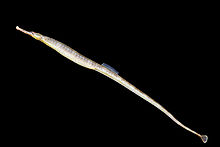
The Syngnathidae is a family of fish which includes seahorses, pipefishes, and seadragons. The name is derived from Ancient Greek: σύν, meaning "together", and γνάθος, meaning "jaw". The fused jaw is one of the traits that the entire family have in common.

Pipefishes or pipe-fishes (Syngnathinae) are a subfamily of small fishes, which, together with the seahorses and seadragons, form the family Syngnathidae.
Leptonotus is a genus of pipefishes of the family Syngnathidae. The name is derived from the Greek leptos meaning "thin" and noton meaning "back".

Stigmatopora is a genus of pipefishes native to the Indian and Pacific Oceans.
The longsnout pipefish is a pipefish of the family Syngnathidae. It has only been recorded from midwater and bottom trawls at depths of 37–212 metres (121–696 ft). The habitat and biology of this species are almost unknown but juveniles have been recorded in the stomachs of blue penguins and Snares penguins.

The greater pipefish is a pipefish of the family Syngnathidae. It is a seawater fish and the type species of the genus Syngnathus.
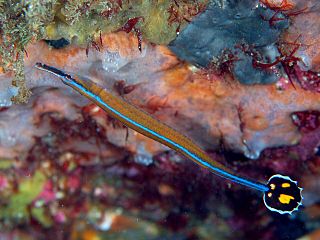
Doryrhamphus and Dunckerocampus, popularly known as flagtail pipefish, are two genera of fishes in the family Syngnathidae. They are found in warm, relatively shallow waters of the Indo-Pacific, with a single species, D. paulus, in the eastern Pacific. Most of these pipefishes are very colourful, and are fairly popular in the marine aquarium hobby despite requiring special care and not being recommended for beginners.
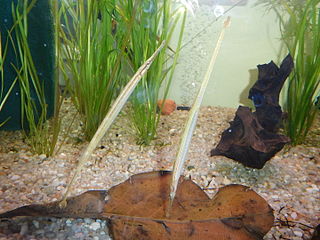
Microphis is a genus of pipefishes within the family Syngnathidae. Members of this genus are notable among the Syngnathidae for residing in mainly fresh and brackish waters. Adults breed in coastal rivers, streams, or lakes, and fertilized eggs are carried by the male pipefish in a brood pouch extending along his entire ventral surface.

The black-striped pipefish is a species of fish in the family Syngnathidae. It is found in the eastern Atlantic from the southern Gulf of Biscay to Gibraltar, also in the Mediterranean and Black Seas. As the introduced species it is mentioned in the Caspian Sea and fresh waters of its basin.

Lake Sapanca is a fresh water lake in Turkey, between the Gulf of İzmit and the Adapazarı Meadow. The lake has a catchment area of 251 km², surface area is 45 km², a length 16 km east–west / 5 km north–south, and a maximum depth of 52 m. Lake Sapanca, Turkey

Doryrhamphus is a genus of pipefishes, one of the two genera colloquially known as flagtail pipefishes and are popular in the aquarium trade. The members of this genus are native to the Indian and Pacific Oceans where they inhabit reef environments. The species in this genus have a maximum length of 14 centimetres (5.5 in) or less, with D. janssi being the only species that surpasses 8.5 centimetres (3.3 in). Most species have a horizontal blue line along their body, and all have a whitish-edged tail that is marked contrastingly with black, red or yellow.

The Hippocampinae are a subfamily of small marine fishes in the family Syngnathidae. Depending on the classification system used, it comprises either seahorses and pygmy pipehorses, or only seahorses.
The Yucatán pipefish is a demersal fish species native to the Gulf of Mexico.
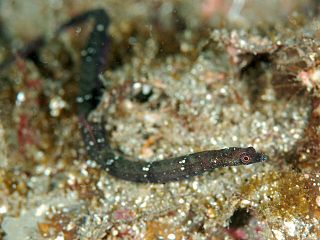
Halicampus is a genus of pipefishes of the family Syngnathidae, containing 12 described species.
Bryx is a genus of pipefishes.
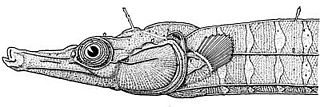
Cosmocampus is a genus of pipefishes.

Syngnathus temminckii is the most common pipefish in southern African estuaries, ranging from Walvis Bay (Namibia) to the Tugela River on the east coast of South Africa.

Doryrhamphus excisus is a species of flagtail pipefish from the genus Doryrhamphus. Its common names include blue-striped pipefish and blue-and-orange cleaner pipefish. The fish is found throughout much of the Indo-Pacific and tropical East Pacific.
Cosmocampus heraldi is a species of marine fish of the family Syngnathidae. It is known from only seven specimens, which were found at the Desventuradas and Juan Fernandez Islands in Chile. It inhabits rocky reefs and sandy areas at depths of 6–23 metres (20–75 ft), where it can grow to lengths of 7 centimetres (2.8 in). It is expected to feed on small crustaceans like other pipefish. This species is ovoviviparous, with males carrying eggs until giving birth to live young.
Cosmocampus howensis is a species of marine fish of the family Syngnathidae. It is found in the South Pacific from Jervis Bay to Easter Island. It lives in lagoons and on rocky reefs, where it grows to lengths of 10–12 centimetres (3.9–4.7 in). It is expected to feed on small crustaceans, similar to other pipefishes. This species is ovoviviparous, with males carrying eggs before giving birth to live young.
